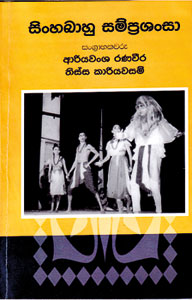"Weditantirige Eustace Reginald de Silva born on June 3, 1914 studied in several schools since his father, Francis Charles de Silva was a postmaster. St Aloysius, Galle, St John's, Panadura and St Thomas' - Mount Lavinia were a few of them. The father and mother were keen to get him to study science. His secondary education was in science subjects. However, the taste he acquired for fine arts through his mother and the two sisters, and the interest he had in oriental languages influenced by a maternal relation came in handy in later years.
 |
"The mother used to sing devotional and western songs with the two daughters Stella and Padma in the night seated on chairs brought out into the garden. The mother being a Wesleyan Methodist and belonging to the D.J. Gogerly generation that propagated the Christian faith criticising Buddhism in a publication titled 'Christiyani Pragnapti' in 1845, was keen on moulding the children in western fashion with a Christian bias. Keen on keeping the son also on the same track she got the son to get boarded in a house at Isipatana Mawatha when he was going to University College. When the mother and the sisters were singing, he joined playing the piano."
Writer, Professor Tissa Kariyawasam recalled the above early days of Professor Ediriweera Sarachchandra in a recent publication. Dr Sarachchandra is one of the few renowned Sri Lankan dramatists whose contribution towards the resurgence of Sinhala drama continues to be acknowledged.
As I sat down to write this column, I saw two advertisements in a morning newspaper announcing that 'Maname' and 'Sinhabahu' - his two milestone productions will be staged during the weekend. Colourful publicity posters for the 'Maname' show are up on the walls in the city. The 50th anniversary of his much talked-about 'Sinhabahu' was celebrated not so long ago. The recently launched monthly SLBC publication, 'Handa' also devoted the third issue to felicitate Sarachchandra.
Interpreting 'Sinhabahu'
The earlier quotation was from a publication titled 'Sinhabahu Samprashansa' released to coincide with the 50th anniversary of 'Sinhabahu'. It is a fine collection of articles which have been written after Dr Sarachchandra's demise in August 1996. While most of the articles discuss the play, there are several which deal with different aspects of Sarachchandra's role in Sri Lanka's literary and theatrical scene.
Amongst the host of Sinhala articles are three in English. Two deal with the play and the other by Professor Ranjini Obeyesekera is on 'Sarachchandra's early criticism and its impact on Sinhala literature.' It was the Sarachchandra commemorative lecture she had delivered as "a gesture to the memory of an old friend and to memories of the University of Peradeniya during the fifties and the sixties."
'Delving into the Lion's den in Sarachchandra's 'Sinhabahu', Dr. Siri Gallage analyses the story according to the philosophy enunciated by Swiss psychiatrist Carl Jung. Summing up, he says: "The story of our mythical origin is a microcosm of our journey from a 'primitive' cave to an organized society, from animal life to human life, and from nature to culture, forming on its way an imprint of our collective experience in the deepest layer of our unconscious.
A father's emotional bond with his son, the son's need to develop his own identity, the crisis created by the transition, the father's grief at the 'loss' of his son, and the son finally taking control of his destiny, are all aspects of the common experience of life. A deeper appreciation of the symbolic meaning of our primordial legends makes any discussion of its authenticity, its biological absurdity and its alleged chauvinistic undertones, pale into significance. What is significant is that as a race we are only human, except that on occasions we bring out the beast in us!"
Discussing the 'Tragic sense of Sinhabahu', authoritative commentator Ariyawansa Ranaweera describes the play as "easily the crest gem of Sinhala dramas." Pointing out the different interpretations of the play, he says for some it is a mother's dilemma between her progeny and the father at a crucial moment of decision-making. For some others it is a father's lament when the children assert themselves and ultimately leave the benign and protective custody of the paterfamilias to seek their own world. Some see a Freudian, ritualistic element where in his description of totem and taboo, the son kills the father to assert the right over the clan. Yet again some say what 'Sinhabahu' brings forth is the eternal confrontation between the older and the younger generations where predictably the latter triumphs. He also refers to the most recent interpretation of a Jungian nature where Dr Siri Gallage avers that the Sinhabahu legend is steeped in the 'common consciousness' of the Sinhala community', which gives it validity.
Pointing out that each of the interpretations is valid, Ranaweera says that these do not exhaust the search for other interpretations. "Thus in the post-modernist sense one can read many meanings into the text of 'Sinhabahu'."
Making a general statement, he says Dr. Sarachchandra's major dramas are all tragedies in the sense that this genre is used in the western tradition." 'Maname', 'Sinhabahu', 'Bava Kadathurawa', 'Pematho Jayathi Soko', 'Loma Hansa' are clearly tragedies in that sense. Even 'Vessantara' which has a happy ending is steeped in pathos. It is interesting to mention here that Dr Sarachchandra who was unmistakably influenced by the forms and traditions of Sanskrit drama, has turned that tradition on its head as far as the thematic treatment is concerned, if not the structural arrangements. "
Stressing that 'Sinhabahu' has firmly established its position as a classic in the annals of Sri Lankan dramatic literature, Ranaweera says that as all other classics of world literature, the future critics would discern myriads of new meanings in the text of 'Sinhabahu'. "This play is truly a many-faceted gem where if one turns it to any side, it emits unique and resplendent beams of light," he concludes. |


